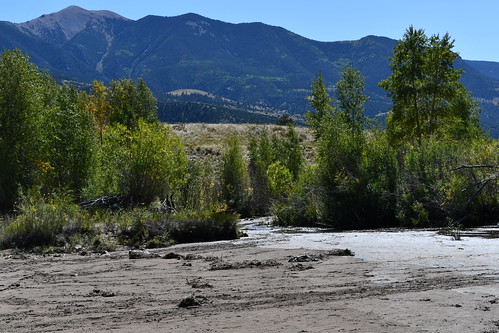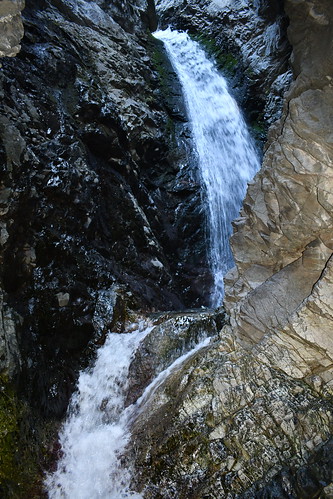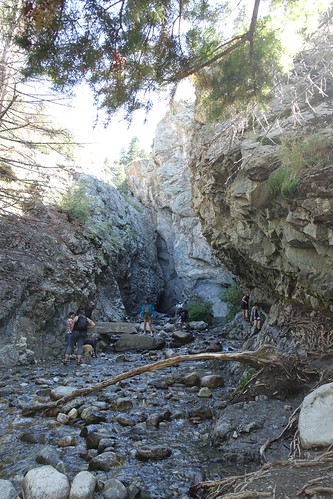History Comes Alive at the Great Sand Dunes National Park
Did you know that there are sand dunes in the southern part of Colorado near the New Mexico border? This unique national park may be a bit off the beaten track, but it is definitely worth the drive.
For decades, I had been fascinated by this geographic wonder and hoped that, one day, I could include this national park in a road trip itinerary. Our stop at the Great Sand Dunes was made in conjunction with a complimentary stay at the nearby Zapata Ranch. Ira and I took a minor detour from the direct route from Denver, Colorado to Santa Fe, New Mexico.

GREAT SAND DUNES
Background Information
I never really understood how sand dunes could form in such an abundance in Colorado until I did research and learned how history comes alive at the Great Sand Dunes. Mother Nature’s paintbrush was set into motion approximately 440,000 years ago when North America’s tallest dunes were created by wind, water movement, erosion, freezing, and thawing. The sand came from the San Juan Mountains 65 mile to the west, and the coarser grains and pebbles originated from the Sangre de Cristo Mountains.

Great Sand Dunes Hiking
Signage at the national park and the park pamphlet describes the complex process. Since the main dune field no longer has a source for new sand, it is no longer growing. However, the dunes near the Medano Creek can grow because this water source is able to bring sand back to that section. Photos taken 138 years apart show minimal changes in the sand dunes.

Sandy hiking up sand hill
The Great Sand Dunes National Park and Preserve’s biodiversity can be appreciated year-round. But keep in mind that the nearby mountains accumulate snow from October to April. Wintertime lows can drop below zero, and summertime highs can hover in the high 80s, causing the sand temperatures to soar to 150 degrees Fahrenheit. While indigenous people have resided in this region since ancient times, the government didn’t recognize the region’s uniqueness until Herbert Hoover’s presidency (1932), when it was protected under the Antiquities Act and was designated a National Monument. In 2004, the area became a national park.
7 Life Zones
Due to a combination of factors—elevation, latitude, climate, and exposure to sunlight— the Great Sand Dunes are home to seven life zones. Streams, creeks, and wetlands promote the growth of narrow-leaf cottonwoods, willows, golden currants, and broadleaf cattail. While I didn’t spot any American white pelicans or American beavers, both are frequent visitors.
The sand zone is divided into three sub-regions—the sabkha, the sand sheet and grassland, and the dunefield. The sabkha is a mixture of crusty white sand and wetlands. Due to its high alkaline ground, plant life is limited, while migratory birds, like the sandhill crane, flourish. More than 50% of this zone is considered a sand sheet and grassland. Due to a high concentration of rabbitbrush, prickly pear, and yucca plants, elk, mule deer, rabbits, and coyotes scamper about in this vegetated area. The more barren dunefield meets the needs of the Ord’s kangaroo rat, and seven rare insect species that can only be found at the Great Sand Dunes. High winds and high temperatures keep others away.
From 8,000 to 9,500 feet above sea level, the montane forest is supreme. Douglas fir, aspen, and narrow-leaf cottonwoods dominate the wetter landscapes, while pinon pines and junipers stick to the sunny slopes. The subalpine forest (9,500-11,500 feet above sea level) is a frosty area receiving notable annual snowfalls. Meadow wildflowers add a splash of color to the surrounding forest filled with Englemann and blue spruce. The highest points of terrain are in the Alpine tundra at elevations above 11,000 feet. Hardy alpine plants grow between the rocks in this frigid environment that is covered with snow 10 months of the year. Pikas, marmots, and ptarmigan roam freely.

Great Sand Dunes hiking
Exploring Medano Pass Road
In retrospect, I would have allotted more than a few hours to wander through these ecosystems and enjoy how centuries of changes sculpted the landscape. Like all other national parks, the acreage is massive and filled with so many fascinating things to explore. We followed the park ranger’s suggestion to avoid the crowds. Fortunately, we had a four-wheel-drive vehicle that could handle the Medano Pass Primitive Road. While we observed cars attempting to make the journey, we highly recommend that you not try to do so without a proper vehicle since the road is filled with boulders, deep ruts, and layers of sand.
Had time not been ticking away and the temperature increasing rapidly, we may have spent more time exploring Sand Pit and Castle Creek, or exploring further down the road. It was mid-September, and steady streams of sunshine were causing the sand to become scorching hot to the touch. A few other visitors scampered up the steep mounds of sand, while others skipped in the ankle-deep stream that ran near the road. The water level will ebb and flow due to the runoff from the mountains, so the stream could be considerably higher or lower at other times in the year.

Panoramic Shot at Castle Creek
Even though the park is known for sandsledding and sandboarding, we didn’t encounter anyone in this less populated area trying out this novel sport. If you plan to try this activity, bring a sled or board from home, or arrange for a rental outside the park. At the time of our visit, it was not possible to rent one onsite.
ZAPATA FALLS
After retracing our steps back to the visitor center, we ended up back on the main road. About eight miles out, we turned at the Zapata Falls Recreation sign and drove a few miles on an extremely bumpy gravel road.
The trail leading to the falls was marked, and included several informative signs. One noteworthy sign described the region. “The San Luis Valley spans 8,000 square miles (that’s bigger than the state of Connecticut) and sits at an average elevation of 7,664 feet. It’s a thirsty landscape that receives less than eight inches of rain per year.”

Zapata Falls
To see the 20-foot waterfall, it is necessary to walk through a rocky stream. I wasn’t wearing waterproof shoes, so I passed on this adventure. Many complained of freezing cold feet. Fortunately, Ira was more prepared for the occasion.

People walking in creek to get to Zapata Falls
ZAPATA RANCH
By the time we reached our car, we were looking forward to downtime at the Zapata Ranch, a 103,000-acre working bison and cattle ranch owned by The Nature Conservancy and managed by Ranchlands. We relaxed in one of the 15 private rooms with its own simple bathroom. Unlike the national park, which greets visitors year-round, the ranch’s season runs from the beginning of March through the end of October.

View from Zapata Ranch with a Telephoto lens
Since our stay was for just one night, our visit only included lodging, as well as a family-style dinner, breakfast, and brown bag lunch. Multiple-day rates include some of the ranch activities, with an option to purchase ala carte ranch activities and a few off-ranch activities.

Sand Dunes View From Zapata Ranch
Bison Tour
Before departing for Santa Fe, we participated in a two-hour bison tour on a nearby parcel called Medano-Zapata Ranch. While looking for the 2,000-head wild bison herd, we learned about the ranch’s history and visited the abandoned Medano Ranch, a small grouping of buildings from the late 19th century. These buildings are listed on the National Registry of Historic Places.

Abandoned 19th century Ranch
Our guide drove us to a place where grazing bison were willing to pose for a photo shoot. We kept a healthy distance away from the herd and used a telephoto lens to get a better look of the bison rolling in the dirt. Our guide used the term, “wallowing,” to describe this behavior. The bison do this to create a dirt barrier that will limit ticks and lice from adhering to their fur. During mating season, male bison may wallow in their urine to announce their sexual condition to competing males. At the end of our tour, we walked around the Bison Barn, where the bison herd is evaluated each fall.

Zapata Ranch Bison Wallowing

Herd of Bison during Ranch Tour
The ranch’s brown bag sandwiches came in handy as we continued on our road trip to Santa Fe. Finally, I had my chance to visit the Great Sand Dunes with the bonus of staying at a conveniently located ranch with spectacular views of the dunes and nearby mountain ranges. Perhaps, one day, we will return so that we can horseback ride into the Great Sand Dunes National Park and spend several days exploring this incredible location.
Sandy Bornstein, the History Comes Alive Through Travel Editor for Wandering Educators, has visited more than 40 countries and lived as an international teacher in Bangalore, India. Sandy’s award-winning book, May This Be the Best Year of Your Life, is a resource for people contemplating an expat lifestyle and living outside their comfort zone. Sandy writes about Jewish culture and history, historical sites, family, intergenerational, and active midlife adventures highlighting land and water experiences.
All photos courtesy and copyright Sandy Bornstein
The Traveling Bornsteins were hosted by the Zapata Ranch and entered the national park using Ira’s lifetime senior pass.




















